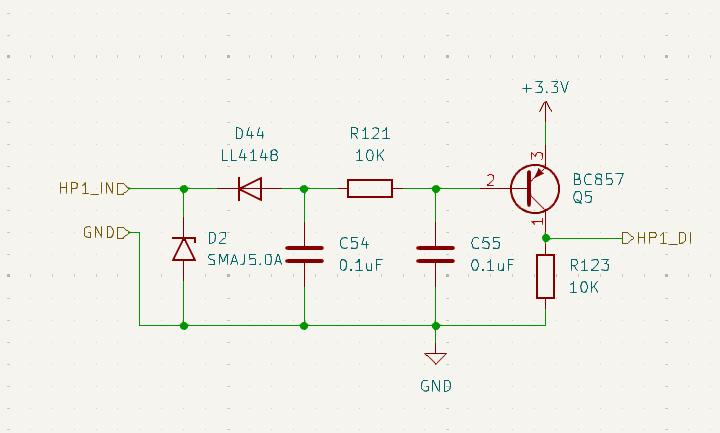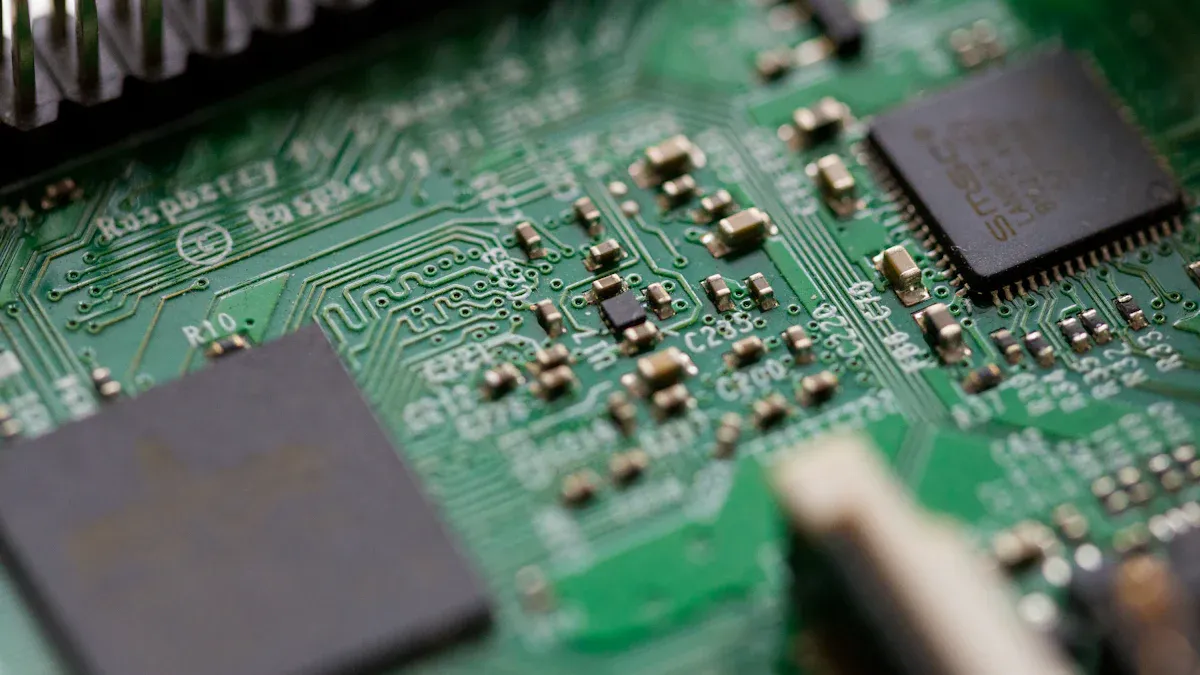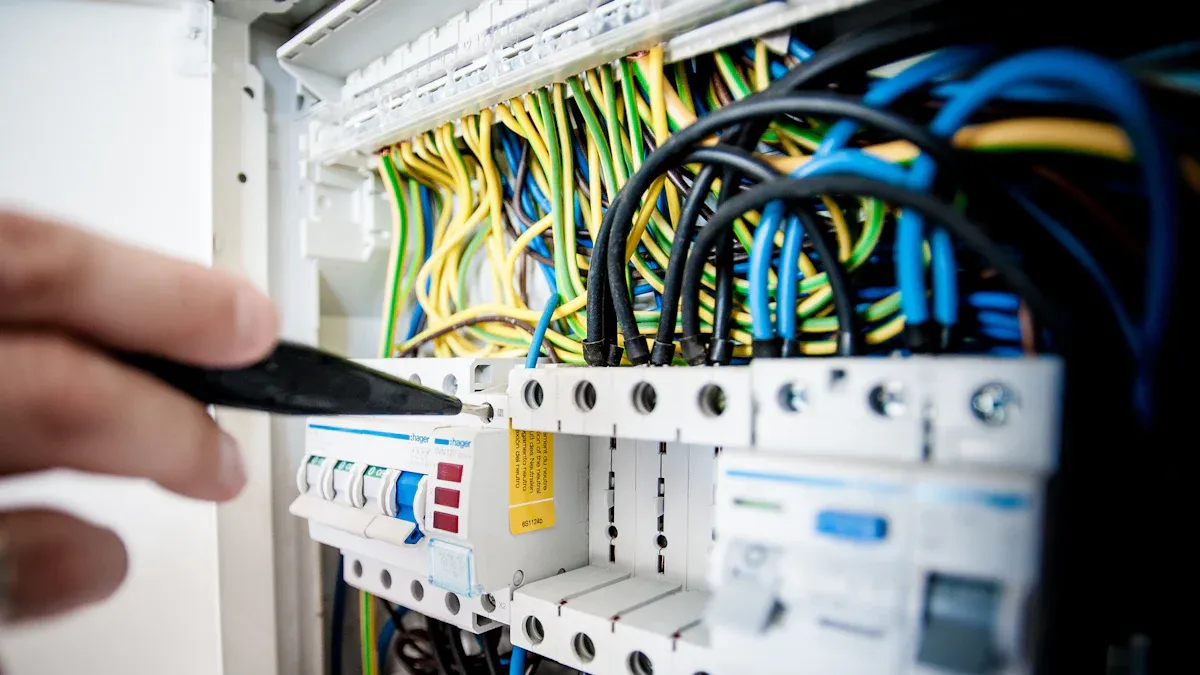Understanding TVS Diodes for Voltage Protection in PNP Switch Circuits

TVS diodes, or Transient Voltage Suppression diodes, are essential components for protecting electronic circuits against voltage surges. These diodes function as a safeguard by clamping excessive voltages, thereby preventing damage to sensitive components. For example, compliance with ISO 7637-2 surge tests highlights the effectiveness of TVS diodes in managing power ratings ranging from 600W to 3,000W, ensuring reliable performance in both 12V and 24V systems.
In PNP switch circuits, the role of TVS diodes is crucial for maintaining circuit stability during transient events. A TVS diode in a PNP switch circuit, such as the TVS diode SMBJ12A or 1.5KE12A, provides efficient suppression of voltage spikes, ensuring the circuit remains safe and operates reliably.
Key Takeaways
TVS diodes keep circuits safe by stopping high voltage surges.
Choose a TVS diode with the right voltage for the circuit.
Place TVS diodes close to important parts to block voltage spikes.
Test and check TVS diodes often to keep them working well.
Adding TVS diodes to PNP switch circuits makes them last longer.
TVS Diodes: Functionality and Applications

How TVS diodes work
TVS diodes operate by clamping excessive voltage during transient events. When a surge occurs, the diode switches from a high-impedance state to a low-impedance state, diverting the excess current away from sensitive components. This rapid response minimizes the risk of damage to the circuit. Unlike regular diodes, TVS diodes are specifically designed to handle short-duration voltage spikes, making them ideal for protecting electronic systems.
SPICE macro-models simulate the behavior of TVS diodes, offering insights into their performance under real-world conditions. Surge tests, such as the 8 × 20-µs and 10 × 1000-µs tests, demonstrate their ability to clamp voltage effectively. Figures from these tests highlight how TVS diodes maintain circuit integrity during transient events.
Types of TVS diodes
TVS diodes come in various types, each suited for specific applications:
Unidirectional TVS diodes: These diodes protect circuits with a single polarity, such as DC systems.
Bidirectional TVS diodes: These are ideal for AC systems or circuits where voltage spikes can occur in both directions.
Surface-mount TVS diodes: Compact and easy to integrate, these diodes are commonly used in modern electronics.
Axial-lead TVS diodes: These diodes are larger and better suited for high-power applications.
Selecting the right type depends on the circuit's voltage requirements and the nature of potential transients.
Applications in circuit protection
TVS diodes play a vital role in safeguarding electronic systems across various industries:
Automotive electronics: They protect sensitive components from voltage spikes caused by load dumps or inductive switching.
Telecommunication systems: TVS diodes ensure stable operation by suppressing transients in signal lines.
Consumer electronics: Devices like smartphones and laptops benefit from TVS diodes, which shield them from electrostatic discharge (ESD).
Industrial equipment: High-power TVS diodes prevent damage to machinery during electrical surges.
In a PNP switch circuit, TVS diodes like SMBJ12A or 1.5KE12A provide reliable voltage suppression, ensuring the circuit remains functional during transient events. Their integration enhances the overall durability and performance of the system.
Voltage Spikes and Circuit Protection
Causes of voltage spikes
Voltage spikes occur due to sudden changes in electrical energy within a circuit. Common causes include inductive loads, such as motors or solenoids, which generate back electromotive force (EMF) when switched off. Lightning strikes can also induce high transient voltages in outdoor systems. Additionally, switching operations in power grids or faulty components may lead to abrupt surges. These spikes can reach thousands of volts, posing a significant threat to sensitive electronics.
Effects on PNP switch circuits
PNP switch circuits are particularly vulnerable to voltage spikes. Excessive transient voltages can exceed the circuit's maximum allowable voltage, leading to component failure or reduced performance. For instance, a spike of ±15,000 V can damage transistors, resistors, or other elements in the circuit. High peak pulse currents, such as ±43 A, can cause overheating or permanent damage. Without proper protection, these circuits may experience instability, compromising their reliability in critical applications.
Role of TVS diodes in voltage suppression
TVS diodes play a vital role in suppressing voltage spikes and protecting PNP switch circuits. When a transient voltage exceeds the diode's clamping voltage, the diode activates and redirects the excess current away from sensitive components. For example, a TVS diode configuration using two SMBJ12CA diodes in parallel can handle peak pulse currents of up to 45.2 A, ensuring robust protection.
The table below illustrates key parameters for circuit protection using TVS diodes:
Parameter | Value |
|---|---|
Maximum allowable voltage (Vmax) | 14.4 V |
Clamping voltage (Vc) | 19.9 V |
Series resistor (R) | 55 ohms |
Transient voltage (Vs) | ±15,000 V |
Peak pulse current (Ip) | ±43 A |
Peak pulse current rating (TVS) | 22.6 A |
Required TVS diode configuration | Two SMBJ12CA in parallel (45.2 A) |
By integrating TVS diodes into a PNP switch circuit, engineers can ensure reliable operation even during extreme transient events. This protection enhances the circuit's durability and prevents costly repairs or replacements.
Selecting the Right TVS Diode
Key parameters to consider
Choosing the correct TVS diode requires understanding key parameters that influence its performance. The working voltage is one of the most critical factors. It defines the maximum voltage the diode can handle during normal operation. The clamping voltage is equally important, as it determines the voltage level to which the diode will clamp during a transient event. For circuits with high-speed signals, capacitance becomes a crucial consideration. Low capacitance ensures minimal interference with signal integrity.
Power rating is another essential parameter. It indicates the maximum energy the diode can absorb during a surge. Applications requiring robust protection should prioritize diodes with higher power ratings. Additionally, the IEC 61000-4-2 rating provides insight into the diode's ability to withstand electrostatic discharge (ESD). A higher rating ensures better protection against ESD events.
Parameter | Description |
|---|---|
Working Voltage | The recommended operating voltage of the TVS diode; the signal voltage should not exceed this value. |
Clamping Voltage | The voltage to which the TVS diode clamps during an ESD strike, protecting the circuit from high voltages. |
Capacitance | The inherent capacitance of the diode; important for high-speed signals where low capacitance is preferred. |
Power Rating | Indicates the maximum power the diode can handle; must be chosen based on the application requirements. |
IEC 61000-4-2 Rating | A robustness rating that indicates the level of protection against ESD; higher ratings provide better protection. |
Matching diode specifications to circuit needs
Matching the TVS diode to the circuit's requirements ensures optimal protection. For a PNP switch circuit, the diode's working voltage must align with the circuit's operating voltage. The clamping voltage should be slightly higher than the circuit's maximum voltage to prevent unnecessary activation. High-speed circuits benefit from diodes with low capacitance, while power-intensive applications require diodes with higher power ratings.
Common selection mistakes
Common mistakes in selecting TVS diodes can lead to inadequate protection or circuit failure. Choosing a diode with a clamping voltage too close to the operating voltage may result in frequent activation, reducing the diode's lifespan. Similarly, selecting a diode with insufficient power rating can cause it to fail during a surge. Field tests reveal that TVS diodes exhibit lower leakage currents compared to alternatives like metal-oxide varistors. This makes them more suitable for low-voltage applications. Engineers must carefully evaluate these factors to avoid costly errors and ensure reliable circuit protection.
Using TVS Diodes in PNP Switch Circuits

Integration steps
Integrating a TVS diode into a PNP switch circuit requires careful planning to ensure effective voltage protection. The process begins with identifying the circuit's operating voltage and transient voltage levels. This information helps in selecting a suitable TVS diode that matches the circuit's requirements. Engineers should also consider the diode's clamping voltage and power rating to ensure it can handle potential surges without failure.
Once the appropriate diode is selected, the next step involves determining the specific location in the circuit where the diode will provide the most protection. Typically, this is near the PNP transistor or at the input/output terminals where voltage spikes are most likely to occur. Proper integration ensures that the TVS diode in a PNP switch circuit can effectively suppress transients and protect sensitive components.
Placement and orientation
Correct placement and orientation of the TVS diode are critical for its functionality. Engineers should follow these steps to ensure proper installation:
Identify sensitive lines: Locate the parts of the circuit most vulnerable to voltage spikes, such as external interfaces or power supply lines.
Determine the correct orientation of the diode (polarity): Connect the cathode to the negative side and the anode to the positive side of the circuit. Incorrect orientation can render the diode ineffective.
Solder the TVS diode across the line: Install the diode directly across the line needing protection. Use short and solid connections to minimize resistance and ensure efficient operation.
Placing the TVS diode as close as possible to the PNP transistor enhances its ability to clamp voltage spikes before they reach critical components. This strategic placement ensures that the TVS diode in a PNP switch circuit provides optimal protection during transient events.
Avoiding common errors
Several common mistakes can compromise the effectiveness of a TVS diode in a PNP switch circuit. One frequent error is selecting a diode with an inappropriate clamping voltage. If the clamping voltage is too close to the circuit's operating voltage, the diode may activate unnecessarily, leading to premature wear. Conversely, a clamping voltage that is too high may fail to protect the circuit during a surge.
Another common mistake involves improper orientation. Reversing the polarity of the diode can prevent it from functioning correctly, leaving the circuit exposed to voltage spikes. Additionally, placing the diode too far from the sensitive components can increase the response time, reducing its effectiveness.
To avoid these errors, engineers should carefully evaluate the circuit's requirements and follow best practices for installation. Regular testing and validation can also help ensure that the TVS diode performs as intended, providing reliable protection for the PNP switch circuit.
Practical Examples of TVS Diode Applications
Real-world use cases
TVS diodes find applications in diverse industries due to their ability to protect sensitive electronics from transient voltage events. In automotive systems, they safeguard electronic control units (ECUs) from voltage spikes caused by load dumps or inductive switching. For instance, a TVS diode like the SMBJ36A can protect a 24V automotive system from surges during engine cranking.
In telecommunications, TVS diodes shield signal lines from electrostatic discharge (ESD) and lightning-induced surges. A bidirectional TVS diode, such as the P6KE6.8CA, ensures stable operation in high-speed data lines. Similarly, consumer electronics like smartphones and laptops rely on TVS diodes to prevent damage from USB port surges or charger malfunctions. Industrial equipment also benefits from high-power TVS diodes, which protect machinery during electrical faults or power grid fluctuations.
Tip: Engineers should always select TVS diodes based on the specific voltage and power requirements of the application to ensure optimal performance.
Testing and troubleshooting
Testing TVS diodes involves verifying their clamping voltage, response time, and power-handling capabilities. Engineers often use an oscilloscope to observe the diode's behavior during simulated transient events. For example, applying a controlled surge voltage can confirm whether the diode clamps at the specified voltage level.
Troubleshooting typically focuses on identifying issues like incorrect orientation or degraded performance. A multimeter can measure the diode's reverse leakage current to detect potential failures. If the diode fails to activate during a surge, engineers should check for improper placement or mismatched specifications.
Note: Regular testing ensures that TVS diodes remain functional and continue to provide reliable protection over time.
Optimizing circuit protection
Optimizing circuit protection with TVS diodes requires careful design and implementation. Engineers should minimize the lead length between the diode and the protected component to reduce inductance. Placing the diode as close as possible to the source of transients enhances its effectiveness.
Selecting the correct diode type also plays a crucial role. For circuits with bidirectional transients, a bidirectional TVS diode offers superior protection. In contrast, unidirectional diodes work best for DC systems. Additionally, combining TVS diodes with other protective components, such as fuses or resistors, can create a robust multi-layered defense.
Reminder: Proper integration and regular maintenance of TVS diodes significantly improve the longevity and reliability of electronic systems.
TVS diodes play a vital role in protecting electronic circuits from transient voltage events. Their ability to clamp excessive voltages ensures the safety and reliability of sensitive components. Engineers rely on these diodes to safeguard systems across industries, from automotive electronics to consumer devices.
When selecting a TVS diode, key factors like working voltage, clamping voltage, and power rating must align with circuit requirements. Proper placement and orientation further enhance their effectiveness.
Key Takeaway: In PNP switch circuits, TVS diodes provide robust protection against voltage spikes, improving circuit stability and extending component lifespan.
What is the primary function of a TVS diode in a circuit?
A TVS diode protects electronic circuits by clamping excessive voltage during transient events. It redirects the surge current away from sensitive components, ensuring the circuit remains safe and operational.
How do engineers select the correct TVS diode for a PNP switch circuit?
Engineers consider parameters like working voltage, clamping voltage, and power rating. The diode must match the circuit's operating voltage and handle expected surges without failure. Low capacitance is crucial for high-speed circuits.
Can TVS diodes protect against lightning-induced voltage spikes?
Yes, TVS diodes can suppress voltage spikes caused by lightning. Bidirectional TVS diodes are particularly effective in protecting circuits where transients occur in both directions, such as outdoor telecommunication systems.
What is the difference between unidirectional and bidirectional TVS diodes?
Unidirectional TVS diodes protect circuits with a single polarity, like DC systems. Bidirectional TVS diodes handle voltage spikes in both directions, making them ideal for AC systems or circuits with alternating currents.
Where should a TVS diode be placed in a PNP switch circuit?
The TVS diode should be placed near the PNP transistor or at the input/output terminals. This placement ensures it can clamp voltage spikes before they reach critical components, providing optimal protection.
Tip: Always verify the diode's orientation during installation to avoid errors.
See Also
Comprehensive Overview of AD620AN for Television Power Use
IRF820: A Versatile N-Channel MOSFET for Power Solutions
Enhancing Process Control with AD74413RBCPZ Insights
Enhancing Automotive Efficiency Using NXP Microcontrollers MC9S12 Series
CALL US DIRECTLY
(+86)755-82724686
RM2508,BlockA,JiaheHuaqiangBuilding,ShenNanMiddleRd,Futian District,Shenzhen,518031,CN
www.keepboomingtech.com sales@keepboomingtech.com
